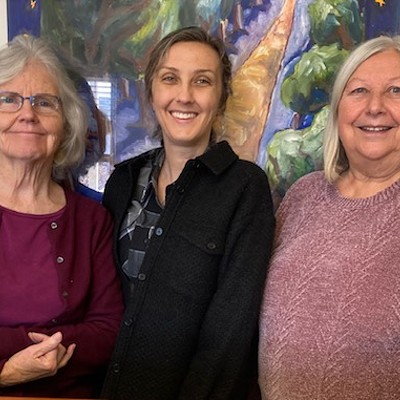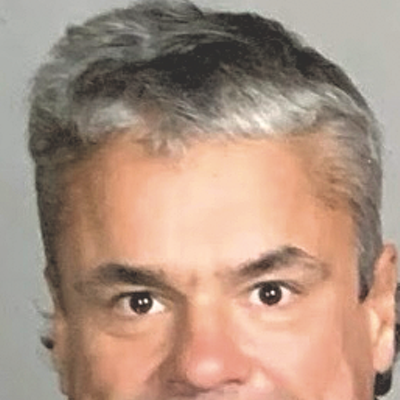
- "The Only Secret" by R.G. Solbert
The nexus of poetry and visual art encompasses more than vivid verbal imagery. “Picture That Poem,” at Studio Place Arts in Barre, demonstrates how diverse and thought provoking the two arts’ links can be.
SPA is known for strongly curated theme shows, and a great idea makes for a fascinating group exhibition. “Picture That Poem” is built on a fresh notion that gave artists plenty of room for creativity in addressing the call for entries, which requested visual art “utterances” and the poems that inspired them.
Many of the poems posted in the show were written by the visual artists themselves. Mark Markowitt is an octogenarian who’s been writing poetry for about three-quarters of a century. He’s been stricken with dementia and is losing his ability to speak. Markowitt’s painting “Tribute to a Lost Love” reflects on a poem entitled “Lament for a Lost Love” that he composed 60 years ago. He completed the accompanying mixed-media abstraction — involving green patches and black dots — with the assistance of an art therapist. Yet, despite his handicap, Markowitt was able to specify that the poem and the painting are integrally linked. “Tribute to a Lost Love” seems like the map of a mysterious tropical atoll.
Markowitt’s wife, Suzy, contributed a 2008 mixed-media watercolor with collage dominated by blue hues, in which the upward movement culminates in a translucent lavender peak. Called “Parallel,” her painting is associated with a 1948 poem by her husband entitled “Inspiration,” which references the Matterhorn.
Janet Van Fleet’s 2009 sculptural construction with text also quotes a family member’s poem, which appears along the edges of the freestanding 38-by-12-by-51-inch sculpture. “Heaven’s Chop Shop” features a tableau in which Lilliputian figures made of bolts, rusty nails and gold thread dismantle a Gulliver-sized skeleton of sticks, laid out like an archaeological burial. Van Fleet uses the poem “Reincarnation,” written by her mother Sandy McKinney, which begins with the lines: The part that arrives at heaven’s chop-shop / doesn’t leave much to work with / but you’re one of the lucky ones . . . To read the whole text, a viewer must circle the sculpture several times — a potentially dizzying experience.
The title of “The Only Secret,” by R.G. Solbert, alludes to two lines of Emily Dickinson: “The only secret people keep / Is Immortality.” Solbert’s 23-by-28-by-5-inch wall sculpture illustrates the Massachusetts poet with an object akin to the winged soul effigies on early New England gravestones. Solbert crafted copper wings and hung an antique wooden shoe stretcher beneath. The shoe element is a graceful and expressive object in the Marcel Duchamp “ready-made” tradition, from about the same era as his 1913 “Bicycle Wheel.”
Three exquisite paintings by Middlesex painter and textile artist Pria Cambio were inspired by the famous Samuel Taylor Coleridge (1772–1834) poem “Kubla Khan; or, A Vision in a Dream: A Fragment.” Much like the Romantic British poet did with words in his opulent masterpiece, Cambio layered color upon color as if they were silken threads in a sumptuous Oriental tapestry. Her 12-by-12-inch “Xanadu: Gate to the City” is a jumble of overlapping gates, walls and domes. The 12-by-24-inch vertical “Xanadu: The Abyss” portrays mountains and lush greenery reminiscent of the opium-induced visions by which Coleridge claimed his pen was fueled.
The artists selected for “Picture That Poem” all produced pieces that inadvertently speak to a saying of Paul Gauguin: “Literary poetry in a painter is something special, and is neither illustration nor the translation of writing by form.” While the poet’s and the visual artist’s tools are quite different, their two mediums may actually be inseparable.









Comments
Comments are closed.
From 2014-2020, Seven Days allowed readers to comment on all stories posted on our website. While we've appreciated the suggestions and insights, right now Seven Days is prioritizing our core mission — producing high-quality, responsible local journalism — over moderating online debates between readers.
To criticize, correct or praise our reporting, please send us a letter to the editor or send us a tip. We’ll check it out and report the results.
Online comments may return when we have better tech tools for managing them. Thanks for reading.